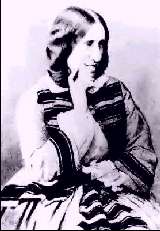
Born: November 22, 1819, in Chilvers Coton, Warwickshire, England
Died: December 22, 1880, in Cheyne Walk, Chelsea, London, England
George Eliot was the pseudonym for the British novelist, critic and poet, Mary Ann Evans. She was a contemporary of Thakeray and Dickens. She introduced realism into British literature, always trying to portray accurate representations. She influenced authors such as Henry James, who, concerned with realism, present what can be seen by the eye.
She was the youngest child of Robert Evans, a land agent. She was educated at Miss Wallington's Boarding School and Misses Franklins' School where she learned etiquette and French. She was converted to Evangelicalism and learned to drop her country accent for proper diction. She was heavily influenced by her governess.
Her mother died when Eliot was sixteen. She returned home to help her father and studied theology, the Romantic poets and German literature at home. When her father retired they went to live at Foleshill near Coventry, where Eliot was accepted into the literary circle of Charles Bray and Charles Hennell.
Her new circle of friends encouraged her to think for herself and to question her religious faith. After a ferocious battle with her father, she agree to attend church, but was not required to embrace its values. This conflict between simple old ways and radical thinking appears frequently in her writing, although she did not give up religious themes.
After her father's death in 1849, she traveled to Europe and lived in London. During this period, she anonymously published her translation of The Life of Jesus, Critically Examined by Dr. David Strauss. She also worked with John Chapman as editor of his journal, The Wesminster Review, while living with his family.
In London, Eliot was associated with many literary and artistic figures, one of whom was George Henry Lewes. Although Lewes was already married, although unhappily, he and Eliot lived together until his death.
Eliot's first successful publication was a serial, The Sad Fortunes of the Reverend Amos Barton. Two more serial publications followed. All three were reprinted in one volume that became extremely successful and caused many readers to speculate about the author's identity. After the serial publications came Eliot's Silas Marner.
She reached the height of popularity in the 1870's with the publication of Middlemarch and Daniel Deronda. In 1880, she married John Walter Cross in 1880, whom she had met in Rome eleven years earlier. He was twenty-one years her junior.